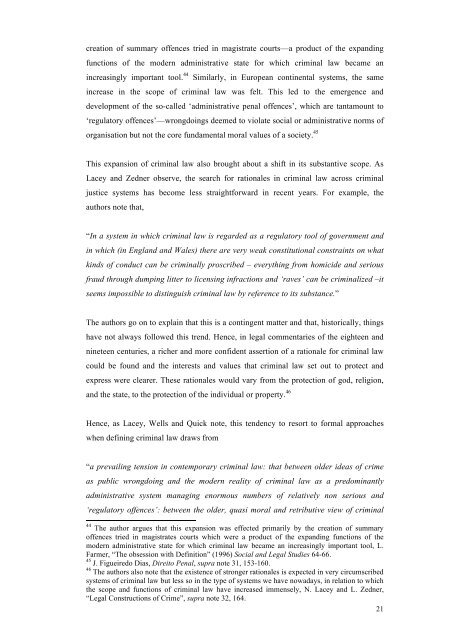The evolution of European Union criminal law (1957-2012)
The evolution of European Union criminal law (1957-2012)
The evolution of European Union criminal law (1957-2012)
You also want an ePaper? Increase the reach of your titles
YUMPU automatically turns print PDFs into web optimized ePapers that Google loves.
creation <strong>of</strong> summary <strong>of</strong>fences tried in magistrate courts—a product <strong>of</strong> the expanding<br />
functions <strong>of</strong> the modern administrative state for which <strong>criminal</strong> <strong>law</strong> became an<br />
increasingly important tool. 44 Similarly, in <strong>European</strong> continental systems, the same<br />
increase in the scope <strong>of</strong> <strong>criminal</strong> <strong>law</strong> was felt. This led to the emergence and<br />
development <strong>of</strong> the so-called ‘administrative penal <strong>of</strong>fences’, which are tantamount to<br />
‘regulatory <strong>of</strong>fences’—wrongdoings deemed to violate social or administrative norms <strong>of</strong><br />
organisation but not the core fundamental moral values <strong>of</strong> a society. 45<br />
This expansion <strong>of</strong> <strong>criminal</strong> <strong>law</strong> also brought about a shift in its substantive scope. As<br />
Lacey and Zedner observe, the search for rationales in <strong>criminal</strong> <strong>law</strong> across <strong>criminal</strong><br />
justice systems has become less straightforward in recent years. For example, the<br />
authors note that,<br />
“In a system in which <strong>criminal</strong> <strong>law</strong> is regarded as a regulatory tool <strong>of</strong> government and<br />
in which (in England and Wales) there are very weak constitutional constraints on what<br />
kinds <strong>of</strong> conduct can be <strong>criminal</strong>ly proscribed – everything from homicide and serious<br />
fraud through dumping litter to licensing infractions and ‘raves’ can be <strong>criminal</strong>ized –it<br />
seems impossible to distinguish <strong>criminal</strong> <strong>law</strong> by reference to its substance.”<br />
<strong>The</strong> authors go on to explain that this is a contingent matter and that, historically, things<br />
have not always followed this trend. Hence, in legal commentaries <strong>of</strong> the eighteen and<br />
nineteen centuries, a richer and more confident assertion <strong>of</strong> a rationale for <strong>criminal</strong> <strong>law</strong><br />
could be found and the interests and values that <strong>criminal</strong> <strong>law</strong> set out to protect and<br />
express were clearer. <strong>The</strong>se rationales would vary from the protection <strong>of</strong> god, religion,<br />
and the state, to the protection <strong>of</strong> the individual or property. 46<br />
Hence, as Lacey, Wells and Quick note, this tendency to resort to formal approaches<br />
when defining <strong>criminal</strong> <strong>law</strong> draws from<br />
“a prevailing tension in contemporary <strong>criminal</strong> <strong>law</strong>: that between older ideas <strong>of</strong> crime<br />
as public wrongdoing and the modern reality <strong>of</strong> <strong>criminal</strong> <strong>law</strong> as a predominantly<br />
administrative system managing enormous numbers <strong>of</strong> relatively non serious and<br />
‘regulatory <strong>of</strong>fences’: between the older, quasi moral and retributive view <strong>of</strong> <strong>criminal</strong><br />
44 <strong>The</strong> author argues that this expansion was effected primarily by the creation <strong>of</strong> summary<br />
<strong>of</strong>fences tried in magistrates courts which were a product <strong>of</strong> the expanding functions <strong>of</strong> the<br />
modern administrative state for which <strong>criminal</strong> <strong>law</strong> became an increasingly important tool, L.<br />
Farmer, “<strong>The</strong> obsession with Definition” (1996) Social and Legal Studies 64-66.<br />
45 J. Figueiredo Dias, Direito Penal, supra note 31, 153-160.<br />
46 <strong>The</strong> authors also note that the existence <strong>of</strong> stronger rationales is expected in very circumscribed<br />
systems <strong>of</strong> <strong>criminal</strong> <strong>law</strong> but less so in the type <strong>of</strong> systems we have nowadays, in relation to which<br />
the scope and functions <strong>of</strong> <strong>criminal</strong> <strong>law</strong> have increased immensely, N. Lacey and L. Zedner,<br />
“Legal Constructions <strong>of</strong> Crime”, supra note 32, 164.<br />
21
















